AC-DC-DC Converter for Small Power Energy Storage Systems
Abstract
:1. Introduction
2. Prosumer System Configuration
Requirements
- Energy from renewable sources can be used to supply local loads;
- The ES can be charged (drawing energy from the RES or the grid);
- The energy produced by the RES can be transferred to the power grid;
- Additionally, it is possible to disconnect from the grid and supply the local loads (utilizing energy from RES installation and energy storage), operating in off-grid mode (island mode of operation);
3. Hybrid Inverter
- Hardware Description
- B.
- Control Algorithm
4. Simulation Study
5. Experimental Test Bench
- Functionality tests
- Charging the energy storage (battery) from a renewable energy source;
- Charging the energy storage (battery) from the grid;
- Simultaneously charging the battery from the grid and a renewable energy source;
- Discharging the storage to the grid for local loads;
- Using the islanding operation mode (off-grid mode).
- B.
- Efficiency tests
6. Discussion and Conclusions
Author Contributions
Funding
Data Availability Statement
Conflicts of Interest
References
- Zinaman, O.R. An Overview of Power System Transformation—The Impacts of New Technologies and Innovations; Sao Paulo State Department of Infrastructure and Environment: Sao Paulo, Brazil, 2019. [Google Scholar]
- International Energy Agency. Status of Power System Transformation 2019: Power System Flexibility; International Energy Agency: Paris, France, 2019. [Google Scholar]
- REN21. Renewables 2021—Global Status Report; REN21: Paris, France, 2021; ISBN 978-3-948393-03-8. [Google Scholar]
- Institute of Renewable Energy. Photovoltaics Market in Poland 2023—Report; Institute of Renewable Energy: Warsaw, Poland, 2023. [Google Scholar]
- Ministry of Climate and Environment of the Republic of Poland. Nowe Zasady Rozliczeń Prosumentów od 2022 r; Ministry of Climate and Environment of the Republic of Poland: Warsaw, Poland, 2021. (In Polish) [Google Scholar]
- Polish Power Transmission and Distribution Association (PTPiREE). Raport PTPiREE—Energetyka, Dystrybucja, Przemysł 2021; Polish Power Transmission and Distribution Association (PTPiREE): Poznan, Poland, 2021. (In Polish) [Google Scholar]
- Gabdullin, Y.; Azzopardi, B. Impacts of Photovoltaics in Low-Voltage Distribution Networks: A Case Study in Malta. Energies 2022, 15, 6731. [Google Scholar] [CrossRef]
- Kacejko, P.; Pijarski, P. Ograniczenie wzrostu napięcia spowodowane intensywnym rozwojem fotowoltaiki w sieci nn (Limiting the voltage increase caused by the intensive development of photovoltaics in the low-voltage grid). Energ. Elektr. 2018, 9, 1–11. [Google Scholar]
- Krzemiński, Z. Regulacja napięcia w sieci nN z rozproszonymi źródłami energii. Przegląd Elektrotech 2020, 37–40. (In Polish) [Google Scholar] [CrossRef]
- Rosso, R.; Wang, X.; Liserre, M.; Lu, X.; Engelken, S. Grid-forming converters: An overview of control approaches and future trends. In Proceedings of the 2020 IEEE Energy Conversion Congress and Exposition (ECCE), Detroit, MI, USA, 11–15 October 2020; IEEE: Piscataway, NJ, USA, 2020; pp. 4292–4299. [Google Scholar]
- Andresen, C.A.; Sæle, H.; Degefa, M.Z. Sizing Electric Battery Storage System for Prosumer Villas. In Proceedings of the 2020 International Conference on Smart Energy Systems and Technologies (SEST), Istanbul, Turkey, 7–9 September 2020; pp. 1–5. [Google Scholar] [CrossRef]
- Bhamidi, L.; Sivasubramani, S. Optimal Sizing of Smart Home Renewable Energy Resources and Battery Under Prosumer-Based Energy Management. IEEE Syst. J. 2021, 15, 105–113. [Google Scholar] [CrossRef]
- Zhou, L.; Zhang, Y.; Li, K.; Xie, X. Optimal Sizing of PV System and BESS for Smart Household under Stepwise Power Tariff. In Proceedings of the 2018 International Conference on Power System Technology (POWERCON), Guangzhou, China, 6–8 November 2018; pp. 1314–1319. [Google Scholar] [CrossRef]
- Vairavasundaram, I.; Varadarajan, V.; Pavankumar, P.J.; Kanagavel, R.K.; Ravi, L.; Vairavasundaram, S. A Review on Small Power Rating PV Inverter Topologies and Smart PV Inverters. Electronics 2021, 10, 1296. [Google Scholar] [CrossRef]
- Huang, X.; Liu, Y.; Liao, Y.; Jiang, Z.; He, J.; Li, Y. Modeling of Distributed Energy System with Multiple Energy Complementation. In Proceedings of the 2018 2nd IEEE Conference on Energy Internet and Energy System Integration (EI2), Beijing, China, 20–22 October 2018; pp. 1–6. [Google Scholar] [CrossRef]
- Teichmann, R.; Malinowski, M.; Bernet, S. Evaluation of three-level rectifiers for low-voltage utility applications. IEEE Trans. Ind. Electron. 2005, 52, 471–481. [Google Scholar] [CrossRef]
- Kolantla, D.; Mikkili, S.; Pendem, S.R.; Desai, A.A. Critical review on various inverter topologies for PV system architectures. IET Renew. Power Gener. 2020, 14, 3418–3438. [Google Scholar] [CrossRef]
- Piasecki, S.; Szaniawski, K.; Zaleski, J.; Mienski, R.; Kelm, P.; Jasinski, M.; Chang, Y.C. LV distribution gird stabilisation using Energy Storage System. In Proceedings of the 2023 IEEE 17th International Conference on Compatibility, Power Electronics and Power Engineering (CPE-POWERENG), Tallinn, Estonia, 14–16 June 2023; pp. 1–6. [Google Scholar] [CrossRef]
- Piasecki, S.; Szaniawski, K. Technical Functions of Energy Storage Systems in the LV Distribution. In Proceedings of the 2023 Progress in Applied Electrical Engineering (PAEE), Koscielisko, Poland, 26–30 June 2023. [Google Scholar] [CrossRef]
- Mieński, R.; Wasiak, I.; Kelm, P. Integration of PV Sources in Prosumer Installations Eliminating Their Negative Impact on the Supplying Grid and Optimizing the Microgrid Operation. Energies 2023, 16, 3479. [Google Scholar] [CrossRef]
- Kazmierkowski, M.P.; Krishnan, R.; Blaabjerg, F. Control in Power Electronics. Selected Problems; Academic Press: Cambridge, MA, USA, 2002. [Google Scholar]
- Gruber, J.K.; Prodanovic, M. Residential Energy Load Profile Generation Using a Probabilistic Approach. In Proceedings of the 2012 Sixth UKSim/AMSS European Symposium on Computer Modeling and Simulation, Valletta, Malta, 14–16 November 2012; pp. 317–322. [Google Scholar] [CrossRef]
- Knežević, G.; Mišljenović, N.; Radić, N.; Brandis, A. The optimal use of stationary battery storage in a prosumer power system. In Proceedings of the 2022 7th International Conference on Smart and Sustainable Technologies (SpliTech), Split, Croatia, 5–8 July 2022; pp. 1–6. [Google Scholar] [CrossRef]
- Gabr, A.Z.; Helal, A.A.; Abbasy, N.H. Multiobjective Optimization of Photo Voltaic Battery System Sizing for Grid-Connected Residential Prosumers Under Time-of-Use Tariff Structures. IEEE Access 2021, 9, 74977–74988. [Google Scholar] [CrossRef]
- Masuta, T.; da Silva, J.G.; Fonseca; Ootake, H.; Murata, A. Application of battery energy storage system to power system operation for reduction in pv curtailment based on few-hours-ahead PV forecast. In Proceedings of the 2016 IEEE International Conference on Power System Technology (POWERCON), Wollongong, Australia, 28 September–1 October 2016; pp. 1–6. [Google Scholar] [CrossRef]
- Kornrumpf, T.; Meese, J.; Zdrallek, M.; Neusel-Lange, N.; Roch, M. Economic dispatch of flexibility options for Grid services on distribution level. In Proceedings of the 2016 Power Systems Computation Conference (PSCC), Genoa, Italy, 20–24 June 2016; pp. 1–7. [Google Scholar] [CrossRef]
- Li, X.; Ma, R.; Wang, L.; Wang, S.; Hui, D. Energy Management Strategy for Hybrid Energy Storage Systems with Echelon-use Power Battery. In Proceedings of the 2020 IEEE International Conference on Applied Superconductivity and Electromagnetic Devices (ASEMD), Tianjin, China, 16–18 October 2020; pp. 1–2. [Google Scholar] [CrossRef]
- Papas, I.; Estibals, B.; Ecrepont, C.; Alonso, C. Energy Consumption Optimization through Dynamic Simulations for an Intelligent Energy Management of a BIPV Building. In Proceedings of the 2018 7th International Conference on Renewable Energy Research and Applications (ICRERA), Paris, France, 14–17 October 2018; pp. 853–857. [Google Scholar] [CrossRef]
- Aznavi, S.; Fajri, P.; Asrari, A.; Sabzehgar, R. Energy Management of Multi-Energy Storage Systems Using Energy Path Decomposition. In Proceedings of the 2019 IEEE Energy Conversion Congress and Exposition (ECCE), Baltimore, MD, USA, 29 September–3 October 2019; pp. 5747–5752. [Google Scholar] [CrossRef]
- Yaoyao, F.A.A.; Xiangjun, S.B.L.; Xiaojuan, T.C.H.; Xuecui, F.D.J. Capacity Configuration and Economic Evaluation of Grid-Connected PV and Energy Storage Charging Station. In Proceedings of the 2018 China International Conference on Electricity Distribution (CICED), Tianjin, China, 17–19 September 2018; pp. 3304–3308. [Google Scholar] [CrossRef]
- Jasinski, M.; Wrona, G.; Piasecki, S. Chapter 3: Control of Grid Connected Converter (GCC) Under Grid Voltage Disturbances. In Advanced and Intelligent Control in Power Electronics and Drives; Springer International Publishing: New York, NY, USA, 2014; Volume 531. [Google Scholar]
- Sirimanne, D.C.U.; Kularatna, N.; Arawwawala, N. Electrical Performance of Current Commercial Supercapacitors and Their Future Applications. Electronics 2023, 12, 2465. [Google Scholar] [CrossRef]
- Corti, F.; Laudani, A.; Lozito, G.M.; Palermo, M.; Quercio, M.; Pattini, F.; Rampino, S. Dynamic Analysis of a Supercapacitor DC-Link in Photovoltaic Conversion Applications. Energies 2023, 16, 5864. [Google Scholar] [CrossRef]
- Klokov, A.V.; Tutunin, A.S.; Sharaborova, E.S.; Korshunov, A.A.; Loktionov, E.Y. Inverter Heat Pumps as a Variable Load for Off-Grid Solar-Powered Systems. Energies 2023, 16, 5987. [Google Scholar] [CrossRef]
- Quijano, A.; Lorenzo, C.; Narvarte, L. Economic Assessment of a PV-HP System for Drying Alfalfa in The North of Spain. Energies 2023, 16, 3347. [Google Scholar] [CrossRef]
- Ileberi, G.R.; Li, P. Integrating Hydrokinetic Energy into Hybrid Renewable Energy System: Optimal Design and Comparative Analysis. Energies 2023, 16, 3403. [Google Scholar] [CrossRef]
- Vins, M.; Sirovy, M. Assessing Suitability of Various Battery Technologies for Energy Storages: Lithium-ion, Sodium-sulfur and Vanadium Redox Flow Batteries. In Proceedings of the 2020 International Conference on Applied Electronics (AE), Pilsen, Czech Republic, 8–9 September 2020; pp. 1–5. [Google Scholar] [CrossRef]
- Chen, X.-C.; Zhang, X.-J.; Zhao, H. Air source heat pump energy storage heating system for smart building. In Proceedings of the 2016 Chinese Control and Decision Conference (CCDC), Yinchuan, China, 28–30 May 2016; pp. 3635–3639. [Google Scholar] [CrossRef]
- Waser, R.; Berger, M.; Maranda, S.; Worlitschek, J. Residential-scale demonstrator for seasonal latent thermal energy storage for heating and cooling application with optimized PV self-consumption. In Proceedings of the 2019 IEEE PES Innovative Smart Grid Technologies Europe (ISGT-Europe), Bucharest, Romania, 29 September–2 October 2019; pp. 1–5. [Google Scholar] [CrossRef]
- Islam, S.N.; Saha, S.; Haque, M.E.; Mahmud, M.A. Comparative Analysis of Commonly used Batteries for Residential Solar PV Applications. In Proceedings of the 2019 IEEE PES Asia-Pacific Power and Energy Engineering Conference (APPEEC), Macao, China, 1–4 December 2019; pp. 1–5. [Google Scholar] [CrossRef]
- Barlik, R.; Nowak, M.; Grzejszczak, P. Power transfer analysis in a single phase dual active bridge. Bull. Pol. Acad. Sci. Tech. Sci. 2013, 61, 809–828. [Google Scholar] [CrossRef]
- Krismer, F. Modeling and Optimization of Bidirectional Dual Active Bridge DC–DC Converter Topologies. Ph.D. Thesis, ETH Zürich, Zürich, Switzerland, 2010. [Google Scholar]
- Piasecki, S.; Jasinski, M.; Milicua, A. Brief view on control of grid-interfacing AC–DC–AC converter and active filter under unbalanced and distorted voltage conditions. COMPEL—Int. J. Comput. Math. Electr. Electron. Eng. 2011, 30, 351–373. [Google Scholar] [CrossRef]
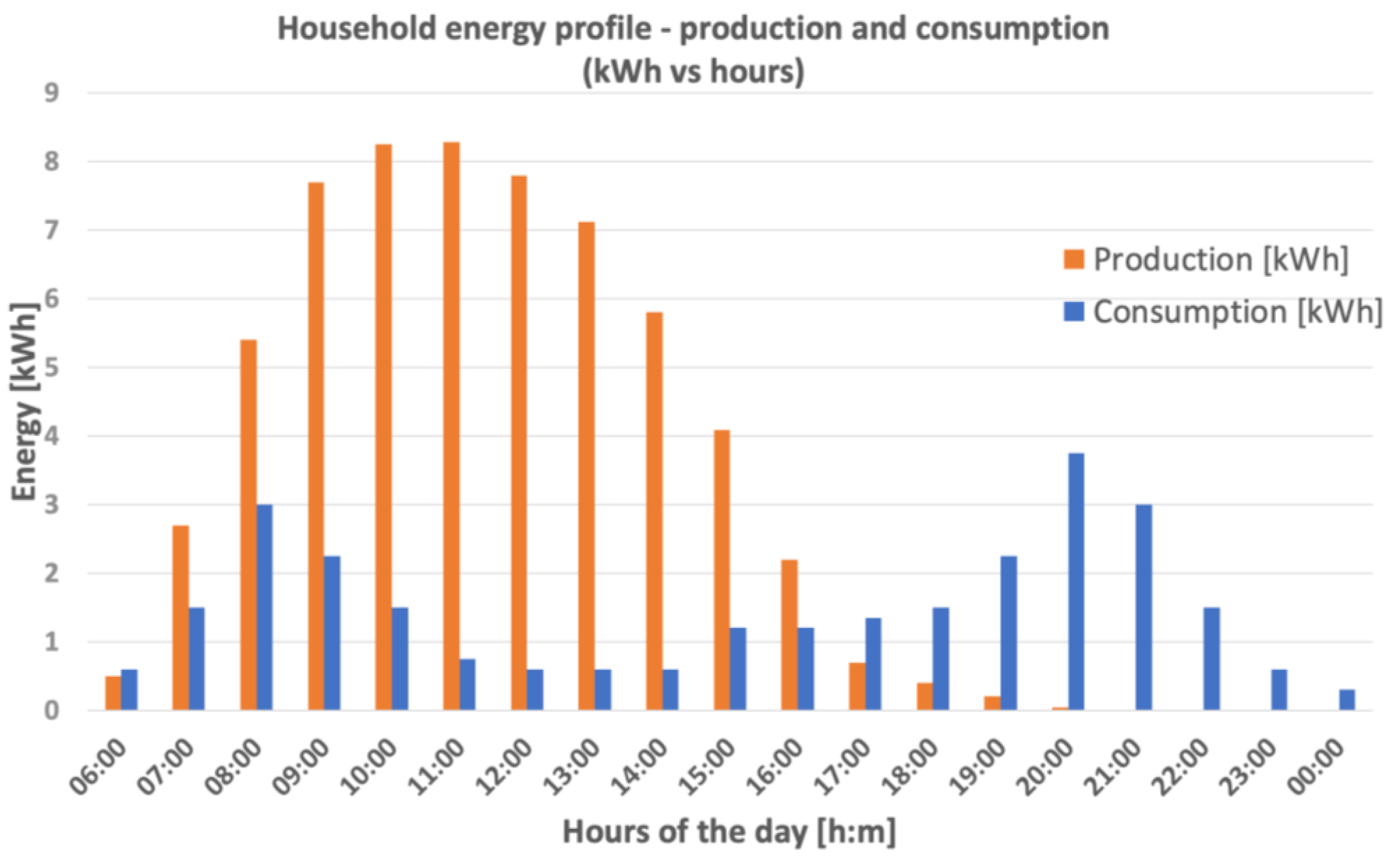




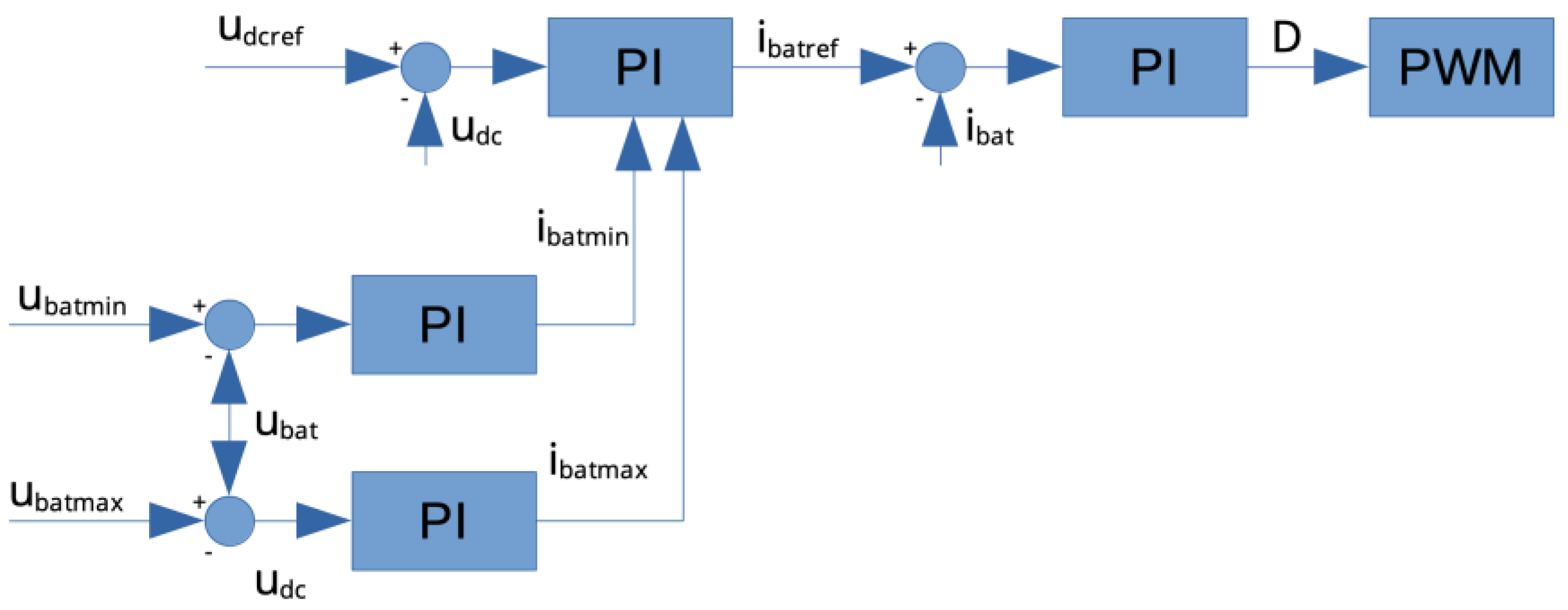
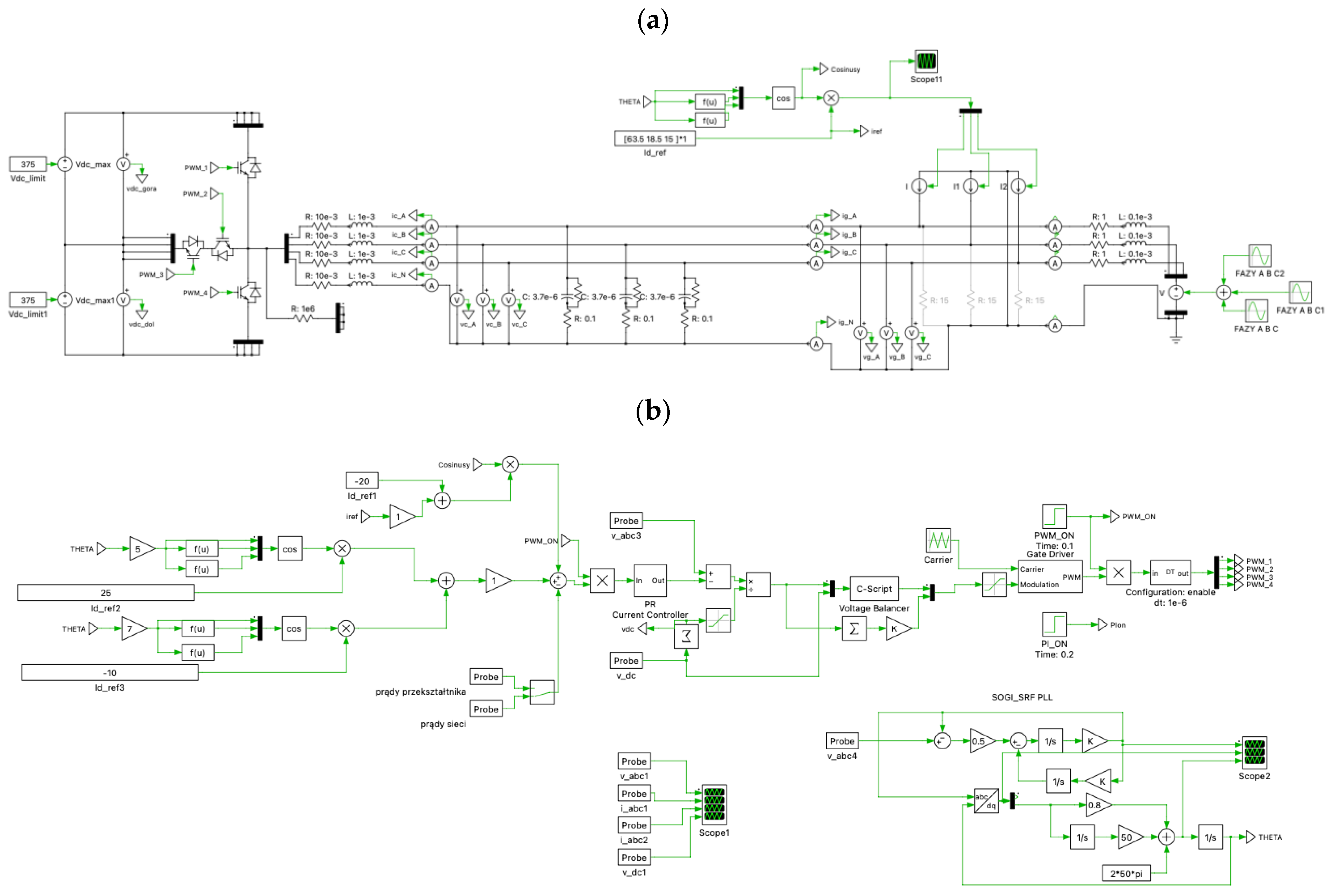
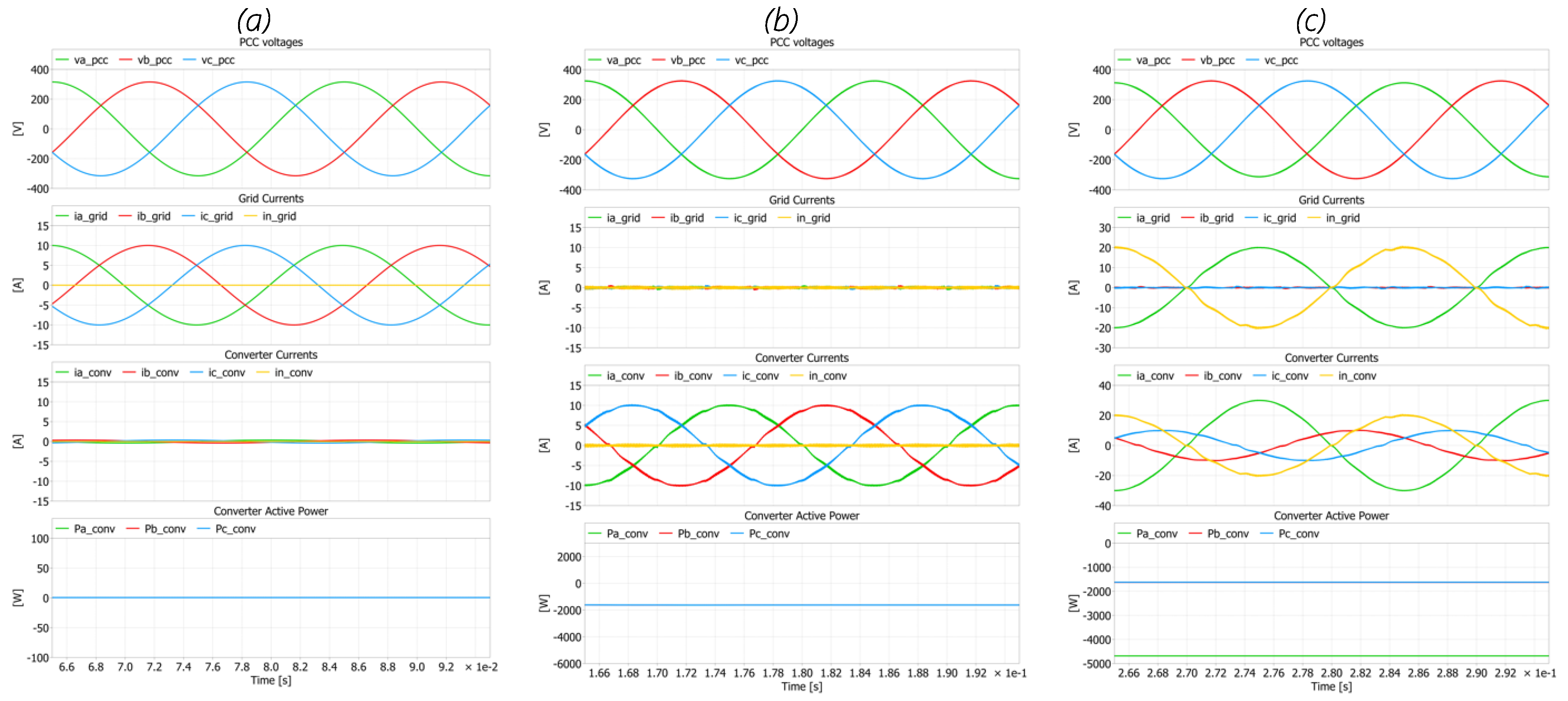
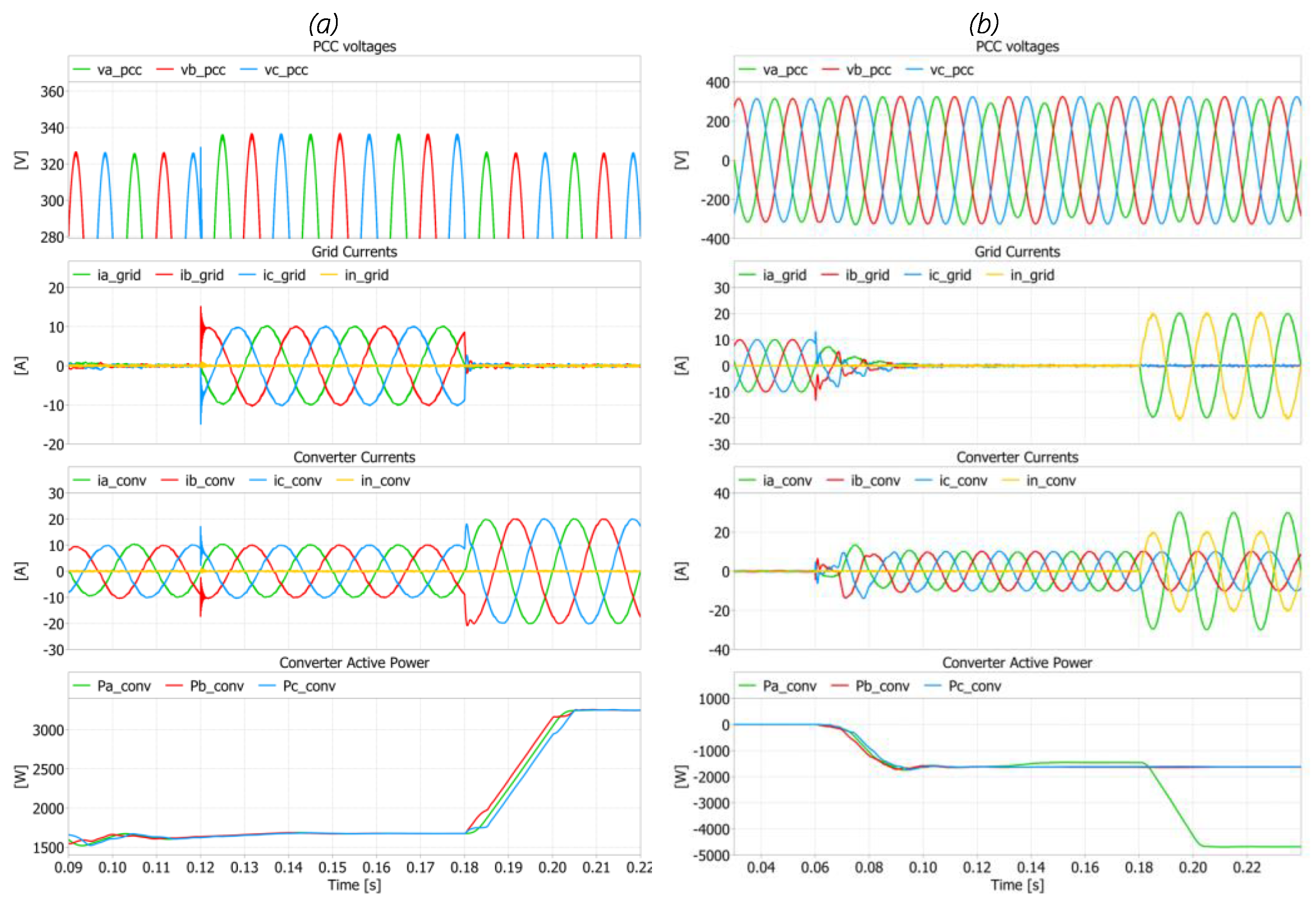

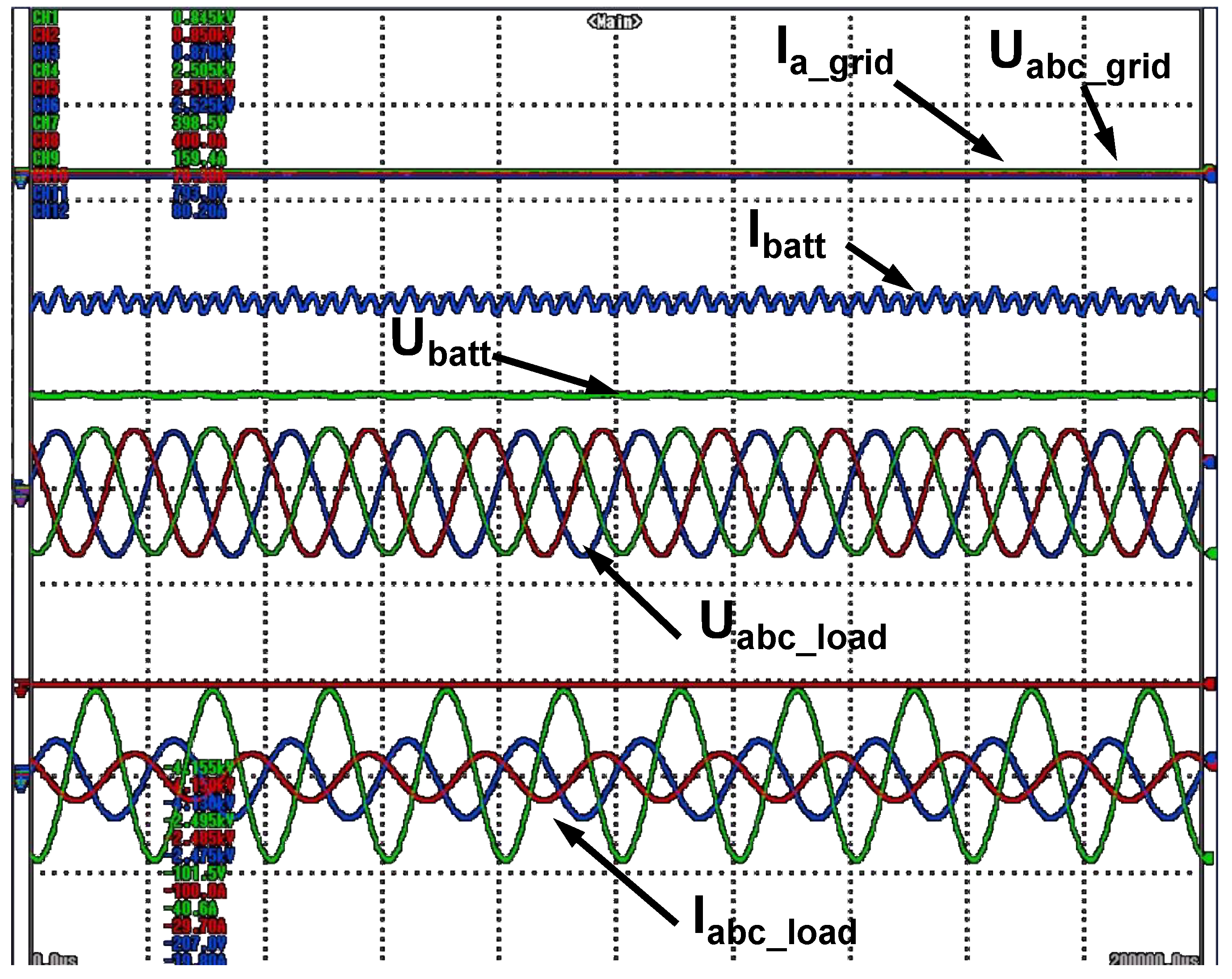

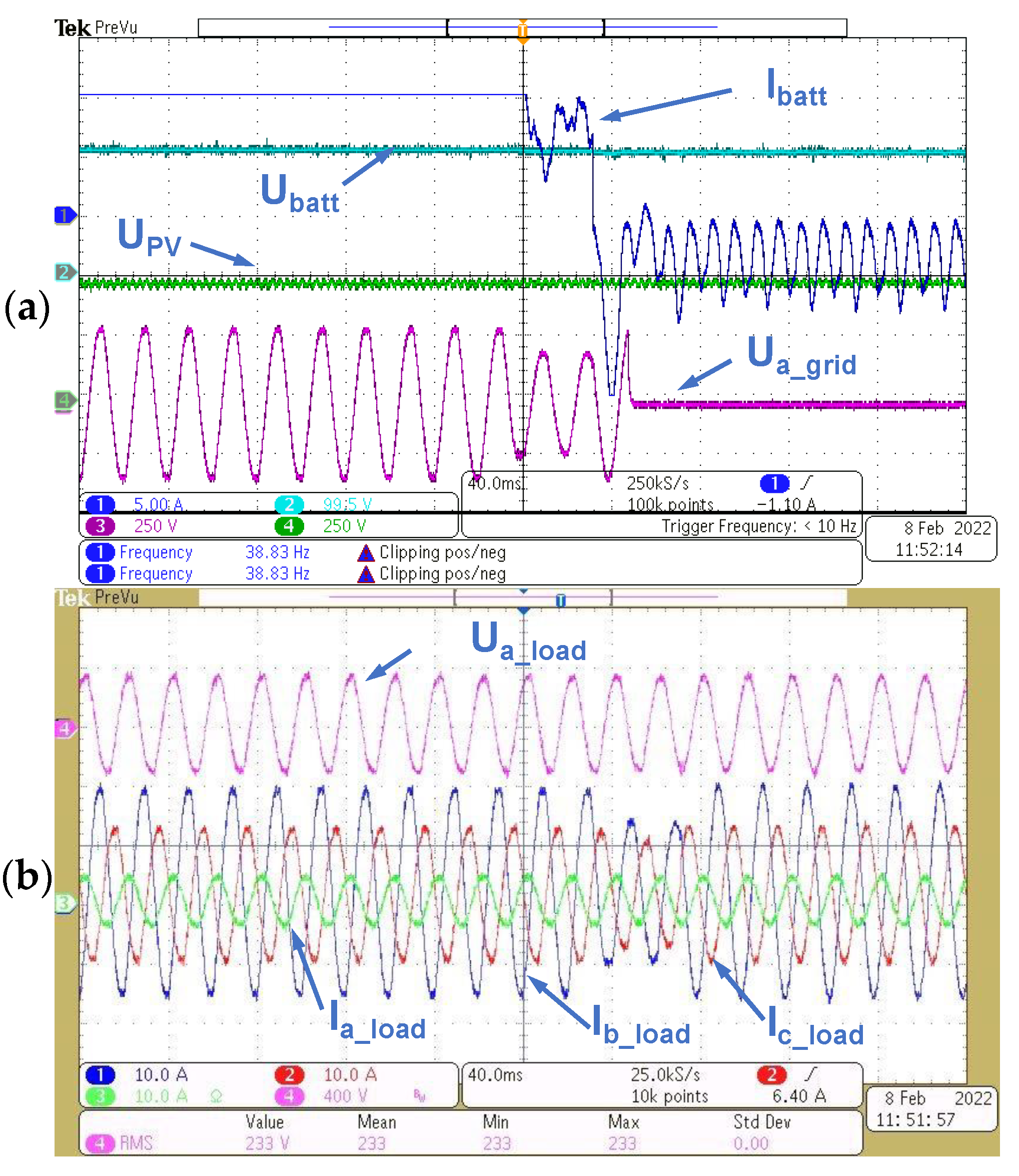


| Symbol | Parameter | Value |
|---|---|---|
| UPV | PV-side voltage range | 60–900 V DC |
| UMPPT | MPPT voltage range | 120–850 V DC |
| IPV-MAX | PV max current | 2 × 15 A |
| UOUT | Output voltage | 3 × 400 V, 50 Hz |
| IOUT | Output nominal current | 18 A |
| fsw | Switching frequency | 16/32 kHz |
| POUT | Nom. power of AC/DC converter | 12 kW |
| UBAT, IBAT | Battery voltage/current | 48–600 V/50 A |
| PBAT | Battery nominal power | 10 kW |
| Operation modes | on-grid/off-grid | |
| AC/DC converter topology | 4-leg, 3-level | |
| Power switches | IGBT (AC/DC), SiC (DC/DC) |
Disclaimer/Publisher’s Note: The statements, opinions and data contained in all publications are solely those of the individual author(s) and contributor(s) and not of MDPI and/or the editor(s). MDPI and/or the editor(s) disclaim responsibility for any injury to people or property resulting from any ideas, methods, instructions or products referred to in the content. |
© 2023 by the authors. Licensee MDPI, Basel, Switzerland. This article is an open access article distributed under the terms and conditions of the Creative Commons Attribution (CC BY) license (https://creativecommons.org/licenses/by/4.0/).
Share and Cite
Piasecki, S.; Bachman, S.; Zaleski, J.; Jasinski, M.; Turzyński, M. AC-DC-DC Converter for Small Power Energy Storage Systems. Energies 2023, 16, 7556. https://doi.org/10.3390/en16227556
Piasecki S, Bachman S, Zaleski J, Jasinski M, Turzyński M. AC-DC-DC Converter for Small Power Energy Storage Systems. Energies. 2023; 16(22):7556. https://doi.org/10.3390/en16227556
Chicago/Turabian StylePiasecki, Szymon, Serafin Bachman, Jarosław Zaleski, Marek Jasinski, and Marek Turzyński. 2023. "AC-DC-DC Converter for Small Power Energy Storage Systems" Energies 16, no. 22: 7556. https://doi.org/10.3390/en16227556







